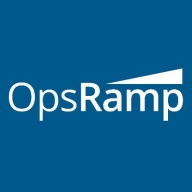

OpsRamp and Elastic Observability are competing products in the field of IT operations and monitoring. Elastic Observability appears to have the upper hand due to its extensive feature set, making it a strong choice for those prioritizing advanced capabilities.
Features: OpsRamp offers hybrid infrastructure management, automated incident management, and multi-cloud monitoring. Elastic Observability is recognized for seamless data integration, real-time analytics, and comprehensive search capabilities.
Room for Improvement: OpsRamp could improve in areas such as user interface customization, more detailed reporting, and enhanced AI-driven insights. Elastic Observability might benefit from simplifying the deployment process, improving documentation for complex setups, and optimizing resource usage in large-scale environments.
Ease of Deployment and Customer Service: OpsRamp provides straightforward deployment with robust support aiming for quicker time-to-value, while Elastic Observability can be complex in deployment, particularly in large-scale environments, but offers high-quality support once set up.
Pricing and ROI: OpsRamp typically offers a lower setup cost, appealing to budget-conscious buyers. Elastic Observability's pricing reflects its advanced functionalities and potential for high ROI, making it particularly appealing for companies with complex needs seeking comprehensive solutions.
Elastic Observability seems to have a good scale-out capability.
What is not scalable for us is not on Elastic's side.
It is very stable, and I would rate it ten out of ten based on my interaction with it.
Elastic Observability is really stable.
It lacked some capabilities when handling on-prem devices, like network observability, package flow analysis, and device performance data on the infrastructure side.
One example is the inability to monitor very old databases with the newest version.
Elastic Observability could improve asset discovery as the current requirement to push the agent is not ideal.
Elastic Observability is cost-efficient and provides all features in the enterprise license without asset-based licensing.
The license is reasonably priced, however, the VMs where we host the solution are extremely expensive, making the overall cost in the public cloud high.
The most valuable feature is the integrated platform that allows customers to start from observability and expand into other areas like security, EDR solutions, etc.
the most valued feature of Elastic is its log analytics capabilities.
All the features that we use, such as monitoring, dashboarding, reporting, the possibility of alerting, and the way we index the data, are important.


Elastic Observability is primarily used for monitoring login events, application performance, and infrastructure, supporting significant data volumes through features like log aggregation, centralized logging, and system metric analysis.
Elastic Observability employs Elastic APM for performance and latency analysis, significantly aiding business KPIs and technical stability. It is popular among users for system and server monitoring, capacity planning, cyber security, and managing data pipelines. With the integration of Kibana, it offers robust visualization, reporting, and incident response capabilities through rapid log searches while supporting machine learning and hybrid cloud environments.
What are Elastic Observability's key features?Companies in technology, finance, healthcare, and other industries implement Elastic Observability for tailored monitoring solutions. They find its integration with existing systems useful for maintaining operation efficiency and security, particularly valuing the visualization capabilities through Kibana to monitor KPIs and improve incident response times.
OpsRamp is a leading cloud-based digital IT operations management platform. The solution allows your organization to leverage hybrid observability, process automation, and machine learning to modernize IT operations. OpsRamp can handle the speed, scope, and scale of modern IT and can help you drive productivity and business value. In addition, it can help your business manage, monitor, and consolidate your point tools and applications.
OpsRamp Features
OpsRamp has many valuable key features. Some of the most useful ones include:
OpsRamp Benefits
There are many benefits to implementing OpsRamp. Some of the biggest advantages the solution offers include:
We monitor all IT Infrastructure Monitoring reviews to prevent fraudulent reviews and keep review quality high. We do not post reviews by company employees or direct competitors. We validate each review for authenticity via cross-reference with LinkedIn, and personal follow-up with the reviewer when necessary.